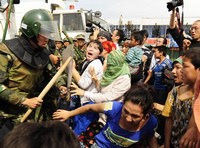On April 6, China’s Ministry of Public Security published a list of six Uighurs wanted for “terrorism” and described as “core members of an extremist group” that had recruited and trained members to carry out terror attacks. The move came on the heels of the latest evidence of Uighur unrest in China’s Xinjiang province and of the local authorities’ nervous reactions to it: The accidental explosion last month of a homemade bomb led police to raid a farm near the city of Korla, killing four Uighurs who, the Chinese authorities themselves later admitted, had nothing to do with the explosion. Nevertheless, a senior Korla security official justified the killings, saying, “Even though they don’t have an organizational link with the bomb maker, their ideology and political views are 100 percent the same. And in addition, we found enough evidence of a terror plan, like axes and boxing gloves.” The raid was one of a number of deadly incidents that took place in March, and follows the violence in late-February in the city of Yecheng -- also known as Kargalik -- that left 20 people dead, including 13 people allegedly stabbed to death by a group of Uighurs and seven of the attackers killed by the police.
As long as the People’s Republic of China (PRC) remained insulated from the international community and kept its borders with Central Asia sealed, Xinjiang and its primary minority, the Uighurs -- who number 10 million and make up more than 40 percent of Xinjiang’s population -- remained of marginal concern to both China and the world. Beijing’s post-1980s policy of opening up to the world, and in particular to Central Asia, has allowed awareness of Uighur aspirations for independence to spread domestically as well as abroad.
Both the Uighurs’ claims and Beijing’s refutations of them are based on historical narratives, partly real and partly invented, that go back hundreds if not thousands of years. History, however, is irrelevant in this case. What matters is reality. Following its “peaceful liberation” by Chinese communists in 1949, Xinjiang was reincorporated into China, which suppressed, sometimes brutally, the remnants of Uighur nationalists who had been associated with the Eastern Turkestan Republic, a semi-independent entity established in 1944 in northwest Xinjiang under Soviet auspices. In 1955, Beijing proclaimed Xinjiang an “autonomous region,” although its autonomy has been quite limited. While the region’s chairman, a symbolic figure, represents a minority, usually a Uighur, the Communist Party secretary and the military commander -- the two strongmen -- have always been Han Chinese. Uighurs suffered persecution, especially during radical upheavals such as the Great Leap Forward and the Cultural Revolution, yet so did other social, religious and intellectual demographic groups, Chinese included. Mao Zedong’s revolutionary fervor notwithstanding, no systematic attempt was made to assimilate the Uighurs.

